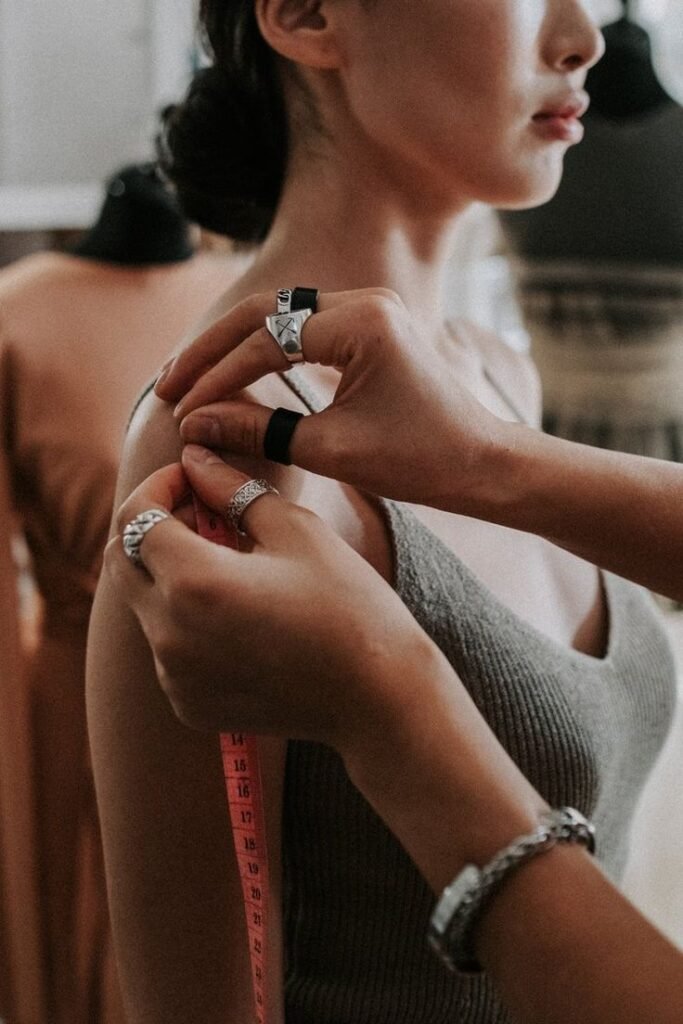
The Importance of Fit in Fashion
When it comes to clothing, fit is one of the most critical elements that can make or break an outfit. The fit is the foundation of any wardrobe, whether it’s winter, fall, or spring fashion.
Proper measurements ensure garments align with the body, allowing ease of movement while accentuating your best features. But not everyone has the time or the equipment.
That’s why understanding sizing guides, measurements, and body-specific fits is key to curating a wardrobe that feels authentic and empowering.
Types of Fit: Tailored, Relaxed, and More
Understanding the different fits helps you select pieces that balance comfort, style, and personality. Here are the most common types:
Tailored Fit
-
Closely contours the body for a neat silhouette.
-
Structured shoulders and fitted waist.
-
Ideal for formal wear, business settings, or polished events.
-
Perfect examples: Tailored blazer, Slim-fit dress shirt.
Relaxed Fit
-
Looser dimensions for ease and comfort.
-
Perfect for casual wear or laid-back looks.
-
Works across many body types.
-
Try staples like Relaxed-fit t-shirt, Wide-leg pants.
Oversized Fit
-
Intentionally larger cut, draping loosely over the body.
-
Popular for layering, especially in fall/winter fashion.
-
Particularly flattering on slender builds.
-
Examples: Oversized hoodie, Boxy denim jacket.
Slim Fit
-
Narrower cut than regular fits.
-
Creates a modern, sleek appearance.
-
Great middle ground between tailored and relaxed.
-
Go for pieces like Slim-fit jeans, Slim-cut polo.
How to Determine Your Ideal Fit
Just in case you have the time, your best fit starts with accurate clothing measurements.
1. Measure Yourself
Use a measuring tape to check bust, waist, hips, inseam, and sleeve length. Reference sizing charts, since brands vary widely.
2. Try Different Styles
See how garments drape on your body. For example:
-
Winter looks may need structured, layer-friendly fits.
-
Spring fashion often favors lighter, breathable fabrics.
3. Consider Fabric
-
Stretchy materials = more flexibility.
-
Structured fabrics = need more precise sizing.
-
Invest in versatile pieces like Stretch chinos or Breathable cotton shirts.
4. Tailoring for Perfection
Even the best off-the-rack piece may need tweaks. A tailoring kit or a visit to a professional can turn a near miss into a custom-feeling garment.
Pro Tip: Think of tailoring as an investment. A perfectly fitted staple will outlast countless “trendy” pieces.
Common Fit Issues and Solutions
Even with careful shopping, fit problems happen. Here are the most common — and how to fix them:
1. Bagginess
-
Issue: Too loose in shoulders, chest, or waist → shapeless silhouette.
-
Fix: Choose better shoulder/chest fits or get tailoring.
-
Helpful tool: Sewing pins to test adjustments before visiting a tailor.
2. Tightness
-
Issue: Restricts movement, uncomfortable in bust, hips, or shoulders.
-
Fix: Size up, opt for flexible fabrics, or select tailored cuts.
3. Length Problems
-
Issue: Garments too long or too short throw off balance.
-
Fix: Consider style context (cropped vs tailored) or get hems adjusted.
-
Handy solution: Hemming tape for quick fixes.
Our Final Thoughts
The right fit goes beyond aesthetics — it shapes confidence, comfort, and personal style. By measuring properly, experimenting with fits, and investing in tailoring, you can curate a wardrobe that not only looks good but feels right for you.